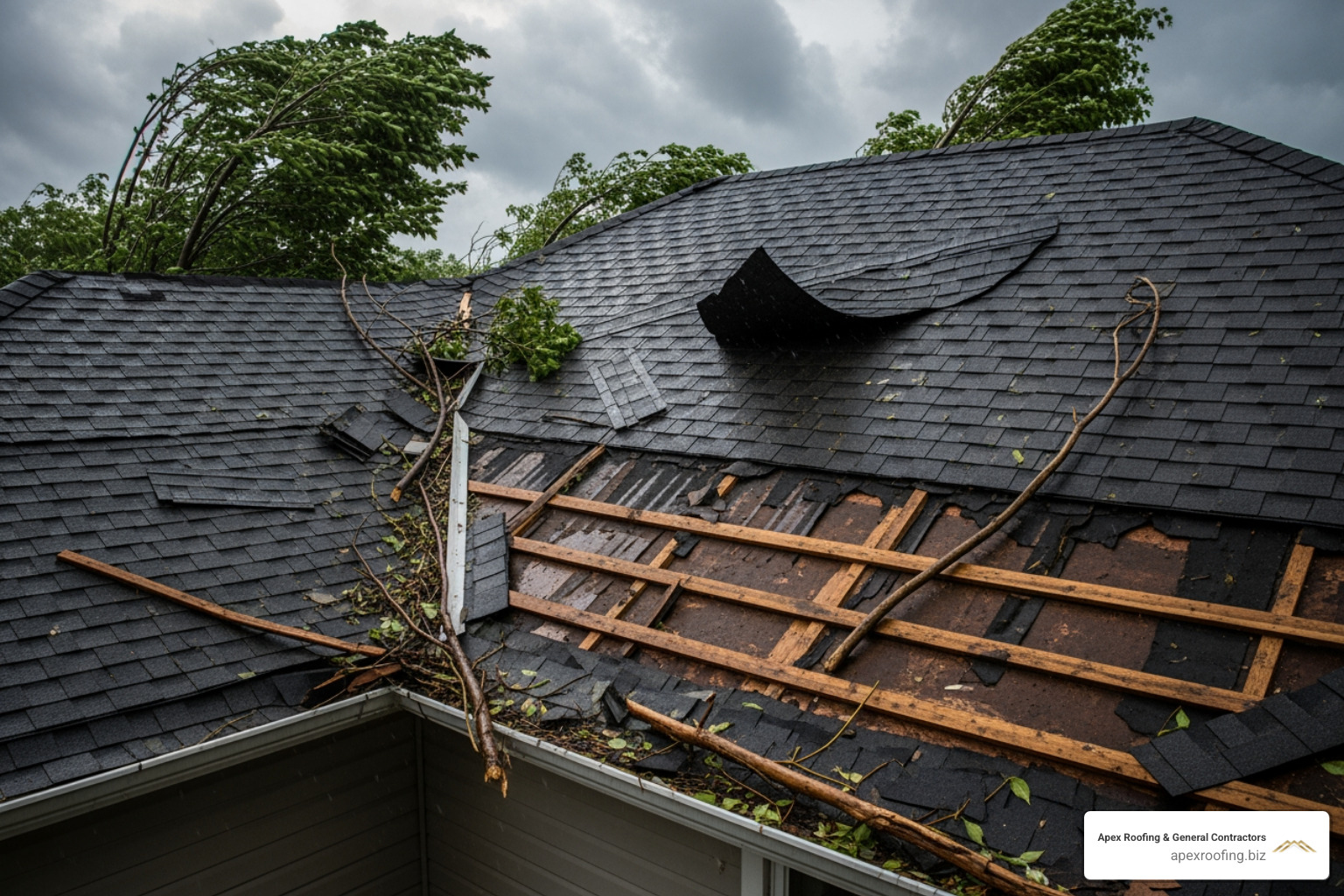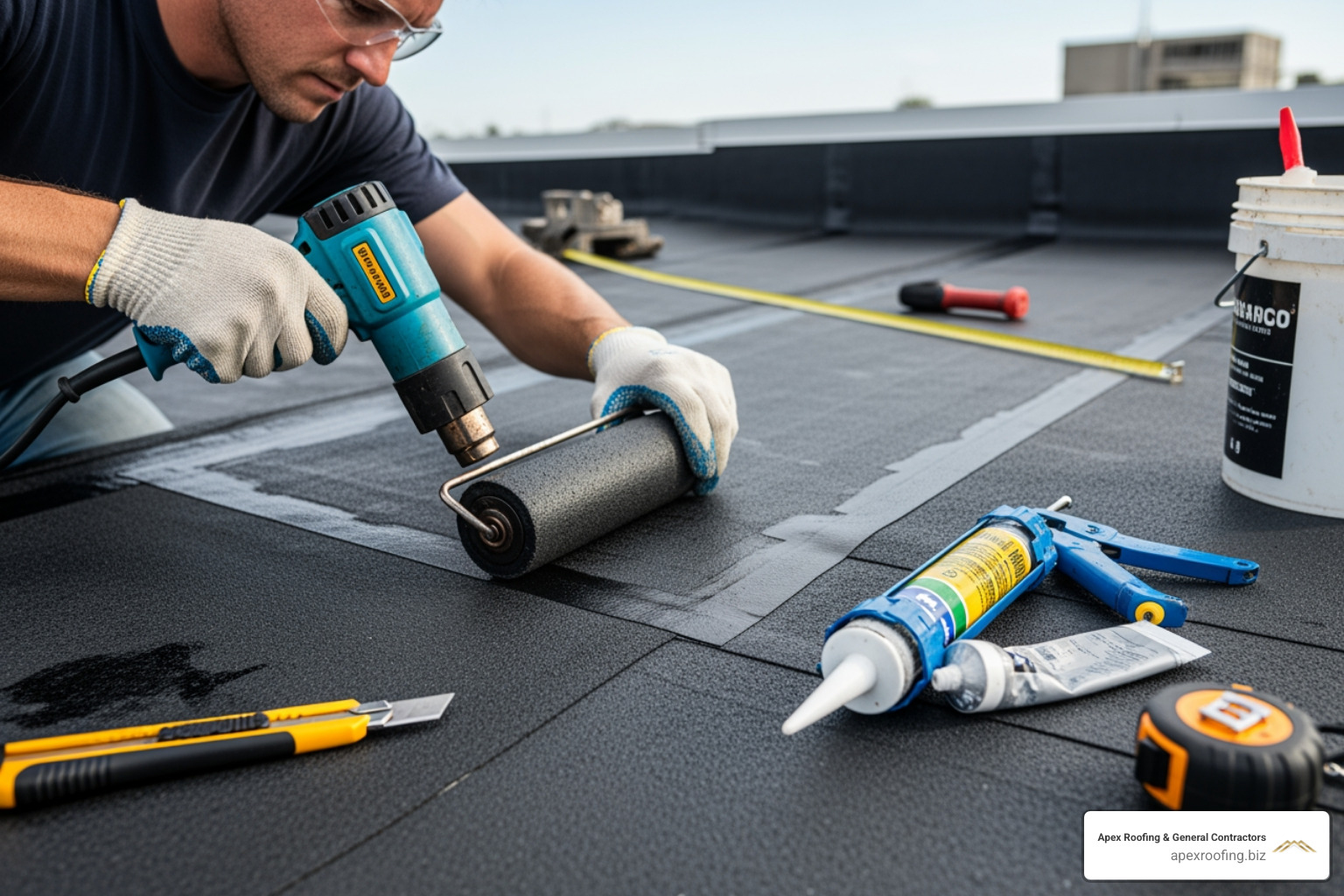Why San Antonio Commercial Buildings Need Professional Roof Replacement
Commercial roof replacement San Antonio is a critical investment for businesses facing the unique challenges of South Texas weather. From triple-digit summer heat to devastating hailstorms, San Antonio’s climate puts tremendous stress on commercial roofing systems.
Quick Answer for San Antonio Business Owners:
- Average Cost: $5-15 per square foot depending on material and complexity
- Timeline: 1-2 days for standard projects, longer for multi-story buildings
- Best Materials: TPO, EPDM, PVC, and metal systems for durability
- Lifespan: 15-30 years with proper installation and maintenance
- When to Replace: Age over 20 years, frequent leaks, or extensive storm damage
Commercial roofs in San Antonio face accelerated aging due to intense UV exposure, thermal expansion, and severe weather events. With the average commercial roof lasting 15-30 years, timing your replacement correctly can save thousands in emergency repairs and business downtime.
Energy efficiency is another major factor. Modern roofing materials can significantly reduce cooling costs – crucial when San Antonio temperatures soar above 100°F for weeks at a time. White TPO membranes, for example, reflect more sunlight and can cut energy bills substantially.
I’m Carlos Yzaguirre, President of Apex Roofing & General Contractors, and I’ve been helping San Antonio businesses steer commercial roof replacement San Antonio projects since 2022. Our team has completed projects across Texas, from small office buildings to large multi-family complexes, always focusing on minimizing business disruption while delivering leak-free results.
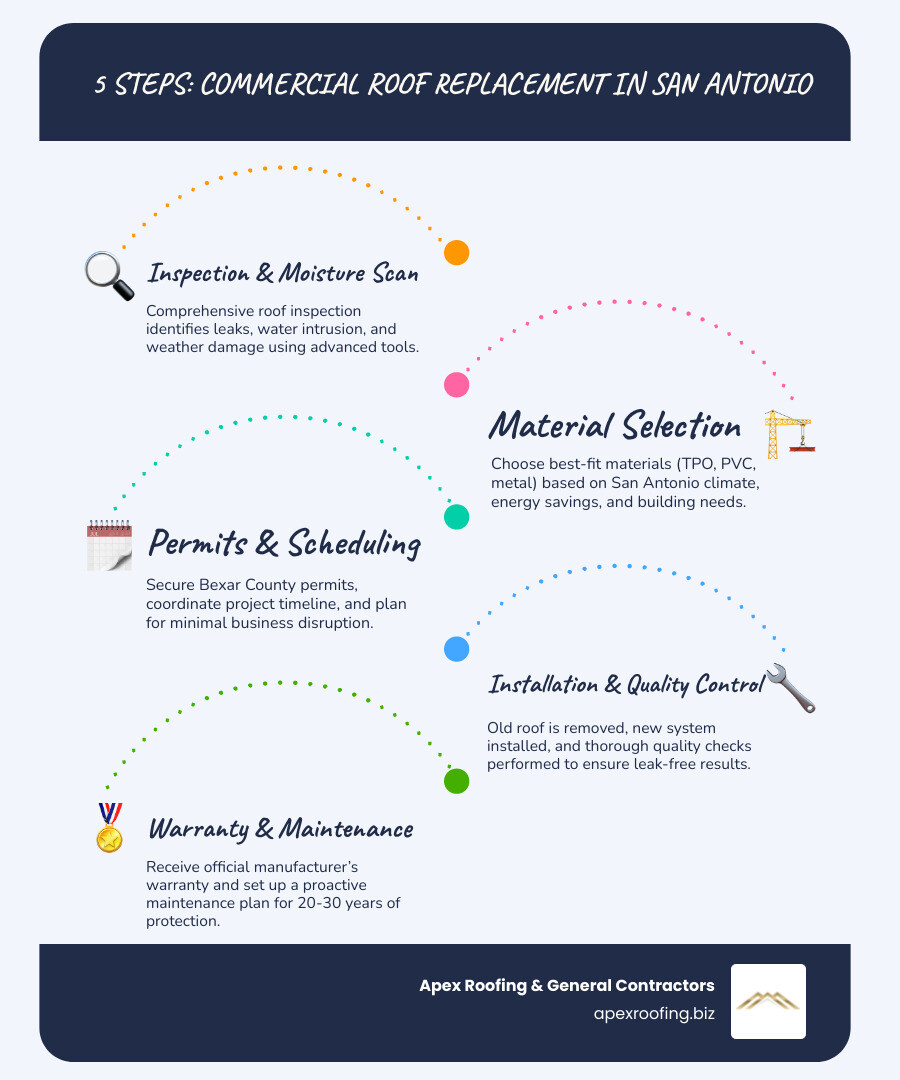
Know your Commercial roof replacement San Antonio terms:
Why Timely Roof Replacement Matters for San Antonio Businesses
When we talk to business owners in San Antonio, Helotes, and Leon Valley, they often ask us why they can’t just keep patching their roof. The answer is simple: delaying replacement costs more money in the long run and puts your business at serious risk.
Energy loss is one of the biggest hidden costs of an aging commercial roof. When your roof’s insulation becomes saturated from leaks or the membrane loses its reflective properties, your HVAC system works overtime. We’ve seen businesses cut their cooling costs by 20-30% after installing modern reflective roofing systems.
Water intrusion doesn’t just damage inventory – it can shut down your entire operation. A leaky roof can destroy office equipment, ruin stored goods, and create mold problems that require expensive remediation. Even worse, water damage can compromise your building’s structural integrity.
Asset protection extends beyond your building itself. Consider the value of what’s inside: computers, machinery, documents, and inventory. A single major leak can cause tens of thousands in damage, far exceeding the cost of proactive roof replacement.
OSHA and local building codes in Bexar County require commercial buildings to maintain safe working conditions. A deteriorating roof can lead to citations, fines, and liability issues if employees or customers are injured.
For more information about cool roofs and heat reduction strategies specific to San Antonio’s climate, check out Scientific research on cool roofs and heat reduction.
How the South-Texas Climate Accelerates Roof Aging
San Antonio’s climate is particularly harsh on commercial roofing systems. We see accelerated aging patterns that don’t occur in milder climates.
Triple-digit heat is our biggest challenge. When temperatures reach 105°F or higher for weeks at a time, roofing materials expand and contract dramatically. This thermal cycling causes membrane stress, seam separation, and fastener loosening.
UV index in San Antonio regularly exceeds 10 during summer months – classified as “very high” by the National Weather Service. This intense ultraviolet radiation breaks down polymer chains in single-ply membranes, causing them to become brittle and crack.
Hailstorms are a constant threat from March through October. San Antonio sits in the heart of “Hail Alley,” where supercell thunderstorms can produce golf-ball-sized hail or larger. Even smaller hail can puncture membranes, crack tiles, and dent metal panels.
Wind uplift during severe thunderstorms can exceed 100 mph in some areas. This creates tremendous stress on roof attachments, especially at corners and edges where wind speeds are highest.
Benefits of Upgrading to Modern Systems
Modern commercial roofing systems are far superior to what was available even 10 years ago. When we replace an old roof with current technology, our clients see immediate benefits.
Energy efficiency improvements are dramatic. Cool roof technologies can reduce surface temperatures by 50-80°F compared to traditional dark roofs. This translates to lower cooling costs and improved comfort for building occupants.
Tax incentives make roof replacement more affordable. Section 179 deductions allow businesses to write off the full cost of qualifying roof replacements in the year they’re installed.
Insurance premium cuts are another benefit. Many insurance companies offer discounts for impact-resistant roofing materials or roofs that meet specific wind resistance standards.
Repair or Replace? Deciding Factors for Commercial Roofs
This is the million-dollar question we hear from every business owner. The decision between repair and replacement depends on several key factors that we evaluate during our comprehensive roof inspections.
Leak frequency is the most obvious indicator. If you’re calling for repairs more than twice a year, replacement usually makes more financial sense. Each repair visit costs money, and temporary fixes don’t address underlying problems.
Age over 20 years is our general threshold for replacement consideration. Even well-maintained roofs reach a point where repairs become increasingly expensive and less effective. The average lifespan of a commercial roof in San Antonio ranges from 15 to 30 years.
Ponding water indicates drainage problems that repairs can’t fix. When water stands on your roof for more than 48 hours after rain, it accelerates membrane deterioration and creates leak risks.
Insulation saturation from repeated leaks compromises your roof’s thermal performance and structural integrity. Wet insulation loses R-value and can harbor mold growth.
| Factor | Repair | Replace |
|---|---|---|
| Age | Under 15 years | Over 20 years |
| Leak frequency | 1-2 per year | 3+ per year |
| Damage extent | Localized | Widespread |
| Energy performance | Acceptable | Poor |
| Total cost (5-year) | Under $15,000 | Over $20,000 |
Red-Flag Signs Replacement Is Needed
We train our inspection teams to look for specific warning signs that indicate repairs won’t be sufficient.
Blistering membrane occurs when moisture gets trapped under the roofing material. As temperatures rise, this moisture turns to vapor and creates bubbles that eventually burst, leaving the roof deck exposed.
Seam failure is common in older single-ply systems. When seams separate or adhesive fails, water can penetrate the entire roof system. Multiple seam failures indicate systemic problems that require replacement.
Rusted panels on metal roofs can’t be effectively repaired once corrosion reaches the substrate. If more than 25% of panels show significant corrosion, full replacement is more cost-effective.
Deck sagging indicates structural problems that must be addressed before any roofing work can proceed. This requires immediate attention for safety reasons.
When Repairs Aren’t Enough
Sometimes we encounter situations where business owners have been patching problems for years, hoping to avoid replacement costs. Unfortunately, there comes a point where repairs actually cost more than replacement.
Persistent leaks that return after repairs indicate underlying problems that can’t be fixed with patches. We’ve seen businesses spend $20,000+ on repairs over two years when replacement would have cost $30,000 and provided decades of leak-free service.
Code non-compliance is increasingly common with older roofs. Building codes evolve to improve safety and energy efficiency. When your roof doesn’t meet current standards, repairs may not be permitted.
Warranty expiration leaves you vulnerable to future problems. Most commercial roofing warranties last 10-20 years. Once warranties expire, you’re responsible for all repair costs.
For more detailed information about commercial roofing services, we offer comprehensive evaluations to help you make the right decision for your business.
Choosing the Right Roofing System for San Antonio Facilities
Selecting the right roofing material is crucial for long-term performance in San Antonio’s challenging climate. We help our clients choose systems that balance durability, energy efficiency, and budget considerations.
TPO (Thermoplastic Polyolefin) is our most popular recommendation for San Antonio commercial buildings. White TPO membranes reflect up to 87% of solar energy, dramatically reducing cooling costs. TPO is also highly resistant to UV radiation, ozone, and chemical exposure. Installation is relatively quick, minimizing business disruption.
EPDM (Ethylene Propylene Diene Monomer) rubber membranes offer excellent durability and weather resistance. While traditionally black, white EPDM provides similar reflective benefits to TPO. EPDM systems are known for their longevity – we’ve seen installations last 25-30 years with proper maintenance.
PVC (Polyvinyl Chloride) membranes use plasticizers for increased strength and hail resistance. PVC is inherently fire-resistant and offers excellent chemical resistance. The heat-welded seams create a monolithic membrane that’s virtually leak-proof when properly installed.
Modified bitumen systems combine the proven performance of built-up roofing with modern materials. These systems are ideal for roofs with heavy foot traffic or equipment loads. Modified bitumen can be torch-applied, cold-applied, or self-adhering depending on the specific product.
Metal panels offer the longest lifespan – 40+ years in many cases. Standing seam metal roofs handle thermal expansion well and provide excellent wind resistance. Metal roofing can withstand wind gusts up to 140 mph and is 100% recyclable, making it an environmentally responsible choice.
Coatings can extend the life of existing roofs by 10-15 years when applied correctly. Reflective coatings reduce surface temperatures and seal minor leaks. However, coatings are only effective on structurally sound roofs with good drainage.
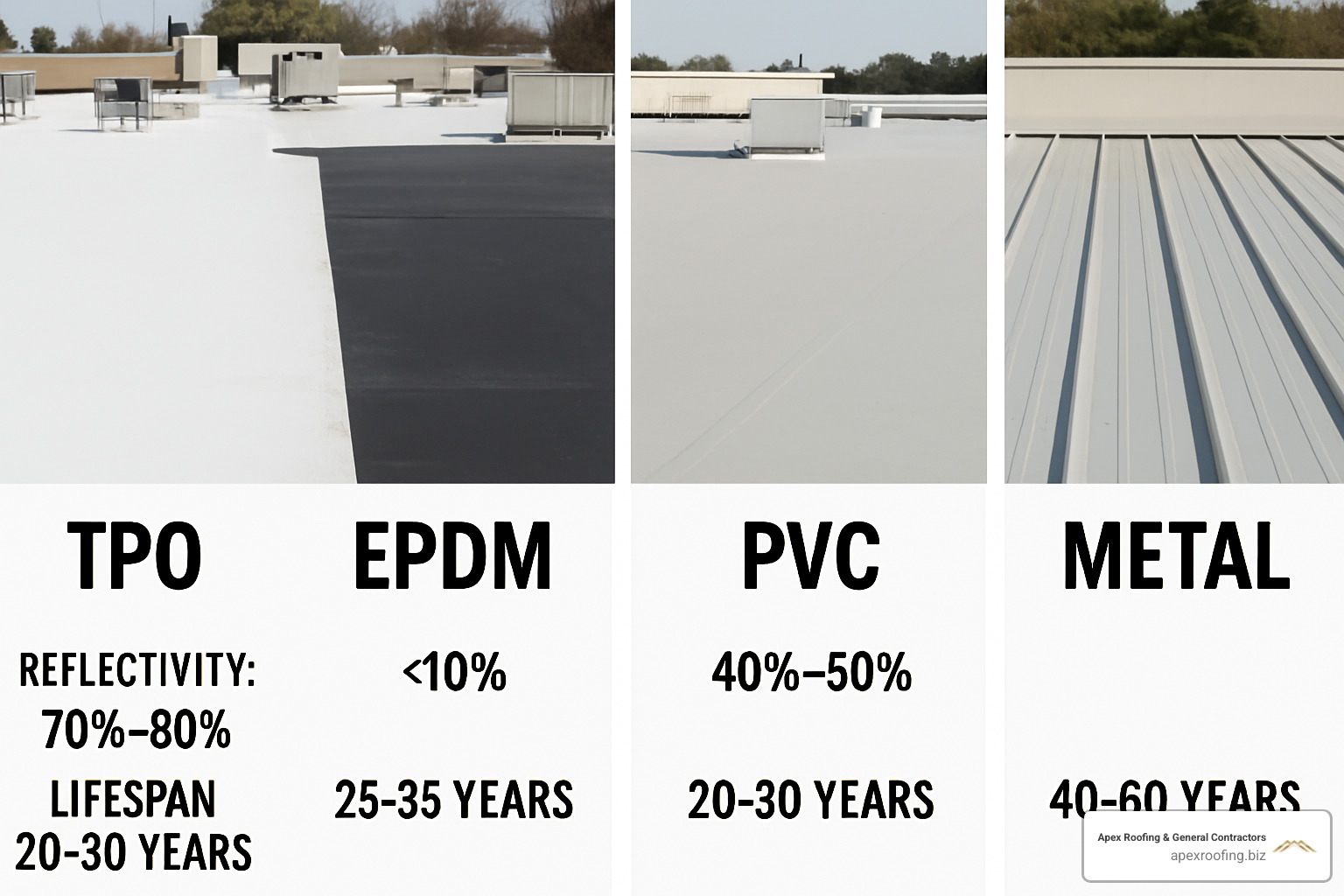
Commercial roof replacement San Antonio: Material Selection Checklist
When we evaluate your building for roof replacement, we consider multiple factors that influence material selection. This systematic approach ensures you get the best long-term value.
Roof slope determines which materials are suitable. Low-slope roofs (less than 2:12 pitch) require different materials than steep-slope applications. Most commercial buildings have low-slope roofs that work well with single-ply membranes or modified bitumen systems.
Foot traffic requirements affect material choice. If your roof supports HVAC equipment, solar panels, or requires regular maintenance access, you need materials that can handle the additional stress. Modified bitumen and some TPO systems are designed for high-traffic applications.
HVAC load considerations include the weight and vibration of rooftop equipment. Heavy units require additional structural support and may dictate specific attachment methods. We coordinate with HVAC contractors to ensure proper equipment integration.
Budget constraints are always a factor, but we help clients understand the total cost of ownership. A more expensive material with longer lifespan and lower maintenance costs often provides better value than cheaper alternatives.
Sustainability goals are increasingly important to businesses. Cool roof technologies, recyclable materials, and energy-efficient systems can contribute to LEED certification and corporate environmental initiatives.
For more detailed information about different roofing options, check out our guide on 3 types of flat roofs.
Internal vs External Drainage & Insulation R-Values
Proper drainage and insulation are critical components of any commercial roof replacement project. These systems work together to protect your building and optimize energy performance.
Tapered ISO insulation creates positive drainage toward roof drains or gutters. This prevents ponding water that can cause premature membrane failure. Tapered systems are custom-designed for each roof to ensure proper slopes and drainage patterns.
Polyiso vs EPS insulation each have specific advantages. Polyisocyanurate (polyiso) provides higher R-values per inch but can lose thermal performance when wet. Expanded polystyrene (EPS) maintains R-value when exposed to moisture but requires thicker installations for equivalent performance.
Code requirements in Bexar County specify minimum insulation levels for energy efficiency. Current codes require R-values of 15-25 depending on the building type and HVAC system. We ensure all installations meet or exceed these requirements.
Internal drainage systems use roof drains connected to interior plumbing. These systems are less visible but require careful waterproofing around penetrations. Internal drains must be properly sized and positioned to handle San Antonio’s intense rainfall.
External drainage relies on gutters and downspouts to remove water from the roof. While simpler to install and maintain, external systems can be overwhelmed during severe storms. We size these systems based on local rainfall data and building codes.
For more information about installation best practices, read our article on commercial flat roof installation.
Step-by-Step Process of Commercial Roof Replacement San Antonio
We’ve refined our commercial roof replacement San Antonio workflow on hundreds of projects, so you get a watertight roof with minimal downtime.
1. Inspection & moisture scan – Thermal imaging, moisture meters, and core samples reveal hidden damage and guide our scope.
2. Scope, proposal & permits – You receive an itemized proposal while we secure all Bexar County permits, safety plans, and scheduling.
3. Tear-off & deck prep – Old materials are removed in contained sections that keep interior spaces clean and dry.
4. Installation – Certified crews follow manufacturer specs for insulation, membrane, flashings, and terminations to qualify for full NDL warranties.
5. Quality check & walk-through – Every seam is inspected, documented, and delivered with a custom maintenance manual.
Pre-Project Planning & Permitting
We handle permit applications, OSHA-compliant safety plans, and coordinate material staging so deliveries and parking stay clear. For more detail, see our guide on the anatomy of commercial roofs.
Live-Roof Replacement: Keeping Operations Running
Most businesses remain open. We replace roofs in 5,000–10,000 sq ft phases, offer after-hours shifts for noise-sensitive tenants, and use debris-containment systems to protect interiors.
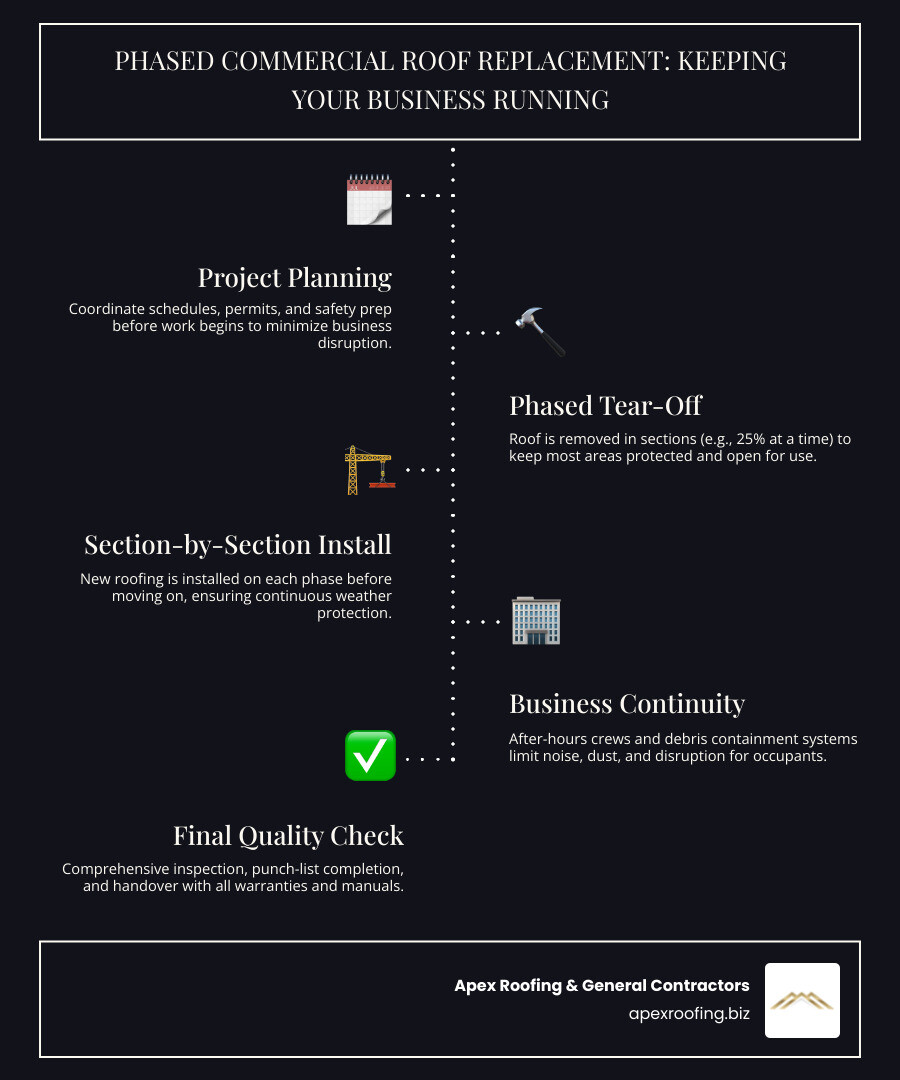
Post-Install Warranties & Guarantees
We secure manufacturer no-dollar-limit coverage for 20–30 years and back it with our own workmanship warranty, giving you a single point of accountability. Learn more about choosing the right partner in our article on commercial roofing contractor selection.
Budgeting, Insurance & Financing Your Commercial Roof
Understanding the financial aspects of commercial roof replacement San Antonio helps you make informed decisions and plan for this significant investment.
Cost per square foot typically ranges from $5-15 depending on material selection and project complexity. Basic TPO installations may cost $5-8 per square foot, while premium systems with extensive insulation upgrades can reach $12-15 per square foot.
Access issues can significantly impact project costs. Buildings with limited crane access, multiple levels, or complex architectural features require additional labor and equipment.
Code upgrades may be required during roof replacement, especially on older buildings. Insulation upgrades, structural reinforcement, or drainage improvements can add to project costs but are necessary for code compliance.
Insurance claims can offset much of your replacement cost when damage results from covered events like hail or wind. We work directly with insurance adjusters to document damage and ensure fair settlements.
Depreciation schedules vary by insurance company and policy type. Some policies provide replacement cost coverage, while others depreciate the roof’s value over time.
Cashflow solutions include financing options that spread replacement costs over several years. Many businesses prefer to finance roof replacement to preserve working capital for other investments.
Navigating Insurance for Storm Damage
San Antonio’s severe weather makes insurance claims a common part of commercial roof replacement. We’ve helped hundreds of clients steer this process successfully.
Adjuster meetings should include your roofing contractor to ensure accurate damage assessment. Insurance adjusters may not be familiar with commercial roofing systems, so having an expert present helps document all damage properly.
Documentation is critical for claim approval. We photograph all damage, provide written reports, and maintain detailed records throughout the process.
Hail reports from the National Weather Service provide objective evidence of storm damage. We maintain records of all significant weather events and can correlate damage patterns with specific storms.
For immediate assistance with storm damage, contact our emergency commercial roof repair team.
Financing & Tax Advantages
Commercial roof replacement offers several financial benefits that can offset the initial investment cost.
Section 179 deductions allow businesses to write off the full cost of qualifying roof replacements in the year they’re installed. This can result in significant tax savings, especially for profitable businesses.
Energy rebates are available for cool roof installations that meet specific energy efficiency criteria. These rebates can reduce your net project cost by $0.50-1.00 per square foot.
For more information about financing options, visit our project financing page.
Minimizing Disruption & Extending Roof Life After Replacement
A new commercial roof is only the beginning. Thoughtful job-site coordination and proactive care afterward protect your investment for decades.
Noise scheduling, tenant notices, and safety signage are organized with property managers so daily operations, customers, and residents stay comfortable and informed.
Maintenance plans – Apex provides a customized checklist with bi-annual inspections, sealant touch-ups, and debris removal that keep your warranty valid. Explore our full range of services on the commercial roofs service page.
Remote Monitoring & Emergency Response
Thermal-drone surveys and a 24/7 leak hotline let us spot small issues before they escalate. For urgent situations, see our guide on navigating emergency roof repairs.
Frequently Asked Questions about Commercial Roof Replacement in San Antonio
How long does a commercial roof replacement project take?
Project duration depends on several factors, but most commercial roof replacements in San Antonio can be completed in 1-2 days for standard projects. Here’s what affects timeline:
Size is the primary factor – a 10,000 square foot roof typically takes 1-2 days, while larger buildings may require a week or more. Complex buildings with multiple levels, extensive equipment, or difficult access take longer.
Material selection impacts installation speed. TPO and EPDM membranes install quickly, while built-up systems or metal roofing require more time. Modified bitumen systems need additional curing time between layers.
Weather can extend project timelines, especially during San Antonio’s storm season. We monitor weather forecasts carefully and adjust schedules to ensure worker safety and installation quality.
Typical timeline for a standard commercial roof replacement:
- Day 1: Tear-off and deck preparation
- Day 2: Insulation and membrane installation
- Day 3: Detail work and final inspection (if needed)
What factors influence cost the most?
Several factors significantly impact the cost of commercial roof replacement San Antonio projects:
Material choice is the biggest cost driver. Basic TPO systems cost $5-8 per square foot, while premium systems with improved insulation can reach $12-15 per square foot. Metal roofing systems typically cost $7-18 per square foot depending on the specific product.
Tear-off complexity affects labor costs significantly. Simple single-layer removals are straightforward, but buildings with multiple roof layers or hazardous materials require specialized handling and disposal procedures.
Code upgrades may be required for older buildings. Insulation upgrades, structural reinforcement, or drainage improvements add to project costs but are necessary for compliance and optimal performance.
Can my business stay open during replacement?
Yes, in the vast majority of cases, your business can remain operational during roof replacement. We’ve developed specialized techniques to minimize disruption:
Phased work allows us to replace sections of your roof while maintaining weather protection over occupied areas. We typically work in manageable sections, completing each phase before moving to the next.
Off-peak scheduling accommodates noise-sensitive operations. We can work evenings, weekends, or during your slow periods to minimize impact on customers and employees.
Containment systems protect your interior from dust and debris. We use plastic sheeting, temporary barriers, and negative air pressure to prevent contamination of occupied spaces.
Conclusion & Free Estimate
When it’s time for commercial roof replacement San Antonio, partner with Apex Roofing & General Contractors—your certified local expert for leak-free, code-compliant roofing across Bexar County and the Hill Country.
From detailed inspections and transparent pricing to minimal-disruption installation and long-term maintenance, we make the process straightforward and cost-effective.
Ready for peace of mind? Request your free estimate and inspection today by calling (726) 727-7663 or visiting our San Antonio roofing team or any of our local service pages. Our specialists will schedule a convenient on-site consultation and present clear options that fit your facility and budget.


